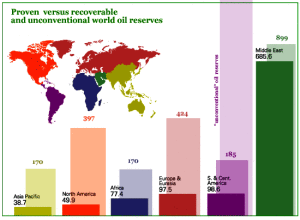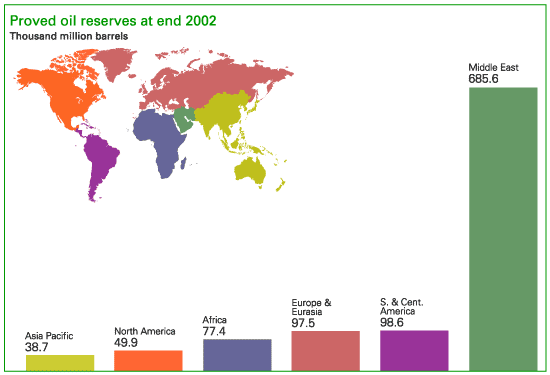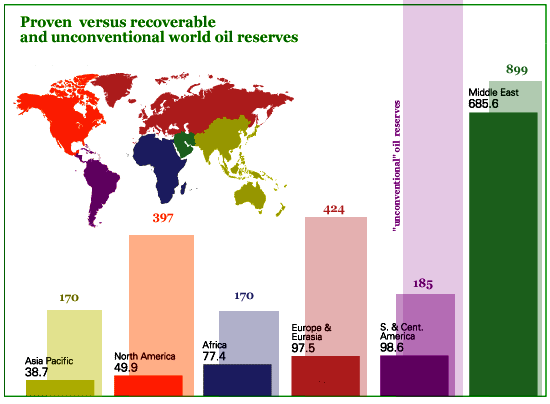By Bill Kovarik, PhD
(First published in 2002). 
- Middle Eastern oil in perspective
- Comparison of USGS and oil industry reserve estimates
- Unconventional oil reserves
- World media has one view of oil reserves
- World oil reserve figures vary considerably in history
- Conclusion and References
Ever since the world’s first commercial oil wells opened in the US and Russia in the 1850s, the question of future oil supply has been controversial. Warnings about the end of oil have been heard in 1882, 1906, 1919, 1932, 1956 and more or less constantly since the 1970s.
Today many people take for granted that oil production has peaked and that two thirds of the world’s oil reserves are found in the Middle East.
These pages present a contrary view based on the idea that oil reserve figures have not been presented honestly by the US and European oil industry. This is not to say that oil won’t run out some day, but rather that the usually uncounted reserves are far larger than are generally known.
To begin with, one of the most revealing speeches about world oil reserves went unremarked in 2006. The head of the world’s largest oil company, Saudi Aramco, said:
“We are looking at more than four and a half trillion barrels of potentially recoverable oil. That number translates into 140 years of oil at current rates of consumption, or to put it anther way, the world has only consumed about 18 percent of its conventional oil potential. That fact alone should discredit the argument that peak oil is imminent and put our minds at ease concerning future petrol supplies.” (From: “The Impact of Upstream Technological Advances on Future Oil Supply” – Mr. Abdallah S. Jum’ah, President & Chief Executive Officer, Saudi Aramco, address to OPEC, Vienna, Austria, Sept. 13, 2006.)
What this means, essentially, is that the Middle East does not have two thirds of all world oil reserves, as has long been claimed by the Saudis, the oil companies and the US Dept. of Energy. It only has two thirds of “proven” oil reserves which are far smaller than the potential reserves Jum’ah describes.
A visual comparison helps clarify the situation. In the BP “conventional view” chart, Middle Eastern reserves dwarf world reserves. Using the same chart, corrected with USGS 2000 World Oil survey, we see a very different picture. These charts are different due to a legacy of flawed information.
Flawed geological information
Consider these typical items from the news:
That more than 60 per cent of the world’s proved oil reserves are in the Middle East, a region wracked by conflict, is a constant source of anxiety for nations that rely on Gulf supplies. In spite of stated efforts to reduce its reliance on Middle East oil, the US has been driven to repeated interventions and support for autocratic regimes to ensure stable energy supplies. — Financial Times, July 5, 2006, p. 8.
If you were to spin the globe and look for real estate critical to building an American Empire, your first stop would have to be the Persian Gulf. The desert sands of this region hold two of every three barrels of oil in the world — Iraq’s reserves alone are equal, by some estimates, to those of Russia, the United States, China and Mexico combined. — Robert Dreyfuss, Mother Jones. March-April 2003
The magic number is 112 billion. That’s how many barrels of oil experts say is oozing through Iraq’s geology — the second largest proven reserves of oil on the planet, just behind Saudi Arabias. — New York Times — Nov. 3, 2002
In the Gulf lie two-thirds of the world’s oil reserves — Financial Times (London) — Dec. 4, 2002
None of the above statements are correct.
To begin with, the Middle East does not have two thirds of the world’s oil reserves.
The oil reserve estimates cited above all refer to a narrow category of “proven” oil reserves, not to “every … barrel of oil in the world” as Mother Jones magazine would have it. Left, right and center, everyone who has written about global energy supply has focused on the problem through a single optic.
According to a US Geological Survey report quietly published in 2000, there is more oil outside the Middle East than inside the region. Certainly two thirds is not at all accurate — It’s 54 percent of identified reserves, possibly 40 percent of ultimately recoverable reserves, and possibly 30 percent or less if you include unconventional heavy oil fields.
As Standard Oil executive Wallace Pratt said in 1944, it is a “fallacy … [to] cite proved reserves as a measure of available future supplies.” Yet this is exactly what has animated US policy in the Middle East.
The news media nearly always use the proven reserve figures and omit other categories because the Department of Energy and the oil industry publish reports that include only “proven” oil reserves — as if that is all there is. Most people do not realize that other petroleum geologists — most notably those at the USGS — take a different view.
The current war in Iraq may or may not be “for” oil, but there is no question that at some level, it is “about” oil. What if Saudi Arabia, Iraq and the Middle East are NOT the home of the world’s largest oil reserves? What if decades of American foreign policy are based on a faulty premise? The implications cut deeply in many directions, but these will be left for the reader.
The point here is to question the premise and get facts on the table.
USGS World Oil Survey 2000
The chart on the next page compares the US Department of Energy’s World Crude Oil and Natural Gas Reserves (created by the oil industry) and the US Geological Survey’s World Petroleum Assessment and Analysis (created by USGS).
The two approaches are very different. DOE and the oil industry have relied on narrow estimates of proven reserves which are the basis of our foreign policy. USGS relies on a more scientific but virtually unknown estimate. If we rely more on the USGS than the oil industry, it is plain that:
* The Middle East does not have two thirds of the world’s oil — it has 54 percent of identified reserves, or, if you look at ultimately recoverable reserves, 39 percent.
* Kuwait — not Iraq — has the second largest identified oil reserves in the world with 99.4 billion barrels, compared to 96.5 for Iraq, according to USGS.
* Saudi Arabia may have one quarter of the world’s identified oil reserves, as the oil industry claims, but it has only about 16 percent of all ultimately recoverable reserves, according to the USGS.
In the report that accompanies the reserve estimates, USGS did not include “unconventional” oil such as Venezuelan heavy crudes. However, the agency did say that these unconventional sources “are approximately equal to the Identified Reserves of conventional crude oil accredited to the Middle East.”
In other words, according to the USGS, and employing a conservative estimate for unconventional oil, the Middle East probably has anywhere from 29 to 35 percent of ultimately recoverable world oil reserves — not two thirds, as is commonly claimed by the oil industry.
Why is the conventional view at odds with the geological view?
What has happened is that “proven” reserves, which reflect the economics of petroleum development, have been the dominant underlying premise in reserve information. Other geologically valid categories of oil reserves have been ignored.
By definition, a proven reserve is one that can be developed economically. But many oil reserves fall somewhat below a standard index of affordability and are therefore not counted.
In addition, there are political issues. Most proven reserves estimates are kept in synch with Organization of Petroleum Exporting Countries (OPEC) estimates, and OPEC production quotas have long been tied to proven reserves. As a result, known oil producing areas are not explored, reserves are not reported, and reported reserves are discounted for commercial and political reasons.
Of course, proven reserves are the appropriate index for oil investment (and in some circumstances it may be required under Generally Accepted Accounting Principles). A reserve that is economically extractable is the only kind a private investor would want. Proven reserves are a burden if you live in a developing nation with undeveloped oil resources. However, if you happen to be a citizen of a nation caught up in the life and death geopolitics of the Middle East, a broader perspective of the geological picture of world oil reserves would, at the very least, be of some interest.
The net effect of the exclusive emphasis on proven reserves is to make people believe that the worlds oil future is — and must always be — centered in the Middle East.
Nothing could be further from the truth.
Some petroleum economists, aware of the fallacy, make this analogy.
Let’s say a company is taking inventory of its stock in order to pay its fair share of taxes. And let’s say that the company decides to count only the stock on its shelves, ignoring the stock in the warehouse. You can imagine what any government would have to say about that. *
That is exactly what has been happening with oil reserves. Yet, when it comes to public policy, it is deceptive to consider only only one type of reserve and not another. There is no reason why journalists or others considering public policy issues should consider what is on the shelves — the “proven” reserves — and never consider what is stored in the”warehouse” of other categories of oil reserves — identified, probable, potential, ultimately recoverable and unconventional.
Obviously, the analogy isn’t entirely accurate. Oil reserves are not so easily counted. But the point is that something is fundamentally askew here, and that we have been led astray by a deceptive technique for handling scientific information.
* The Association for the Study of Peak Oil led by Dr. Colin Campbell makes a similar analogy this way:”Understanding [oil] depletion is simple. Think of an Irish pub. The glass starts full and ends empty. There are only so many more drinks to closing time. It’s the same with oil. We have to find the bar before we can drink what’s in it.”
My comment: Think of a street full of Irish pubs where the price keeps going up because the proprieters claim to be running out of beer. You can see for yourself, they say, the shelf is almost empty. The Ministry for Pubs says its worried and gives the pubs a depletion allowance and other tax breaks. Invasions of other nations with beer making capability are seen as necessary, but politicians promise they will eventually ease our dependence on beer and promote cola drinks just as soon as the beer runs out. What you don’t know is that there is a huge stockpile of beer barrels in the warehouse across town.)


